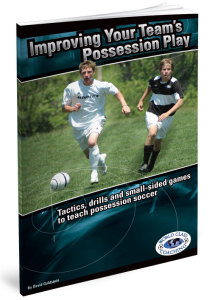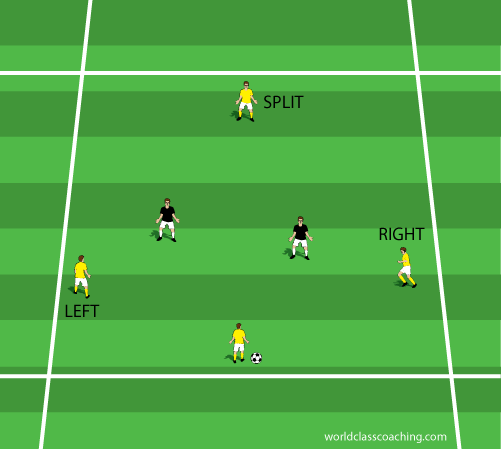Telling a team that they need to, 'Keep possession' is such an abstract and nonspecific concept for so many young players. Teaching them what it takes to keep the ball gives them specific things that they need to do in order to ensure that the team has the best chance to retain the ball.
In David Goldstein's book, 'Improving Your Team's Possession Play' he outlines simple system that can be taught to players at any age or level of play. The core principle is that the player with the ball must have a, 'Left, Right and Split'.
Here is an excerpt that explains this and the other important concepts of the book.
So what is left/right/split support? It is simply that the person with the ball has someone on the left of them for support, someone on the right of them for support and someone working to get into the passing lane between defenders in front of them and into a position that allows the pass to split the defenders. (See Diagram I see page 15) Left/right/split does not imply any direction. The support can be towards the opponents’ goal, towards your own goal or towards the sidelines. Left/right/split is the smallest group function or team tactical issue that consistently appears in the game itself. It is the game within the game. (2 versus 1and 1 versus 1 are smaller group and single confrontations that constantly appear, disappear, and reappear during the course of the match. All a coaches need to be comfortable instructing these concepts. I have addressed 2 versus 1 in the book: Soccer’s 2 versus 1 Handbook.) However, the first time that team tactical issues appear is when the left/right/split structure is demanded of the players.
This diagram shows the basic shape of left/right/split support. It can easily be seen that there are two triangles involved with the quadrilateral shape that left/right/split support provides. This is the basis of the argument about whether the game is played in triangles or in groups of four players that form a square, rectangle or more accurately a quadrilateral shape. It is clear to me that to get complete support that will make the game difficult for the opponent to direct and destroy players must give the three supporting options of
left/right/split support.
While the dynamic exercises that we use to teach the beginning form of this are often in a square or rectangular shape, the shape is only four sided, not necessarily equilateral or equiangular in side length or dimensions. The four sided shape could be diamond, square, rectangular, or squashed into uneven lengths of sides and angles. In math the shape is referred to as a quadrilateral, meaning it has four sides but the angles and side lengths are not equal or in this case predetermined. What must exist are the four sides and three passing options, that magic combination that gives multiple options to the holder of the ball. If one of the options is defended well, then others are available. The availability of players is not specific to distance from the ball or to other teammates. It is specific to the relationship of the defenders, the ball carrier, the supporting players’ relationship to the ball carrier and the defenders, the creation of adequate passing lanes from the holder of the ball to their teammate and the position of the ball. Large group or team tactics and the third of the field that a player is in will effect the decision making of the player, the angle of support or “sharpening” and the amount of pressure a player will allow to be put on the ball before a pass has to be made. This will be discussed at length in a later chapter.
The following are the definitions of the other three teaching directions for the players that are needed before we proceed. The terms are, “sharpening,” “open body” shape, and good “first touch.”
“Sharpening” refers to a players’ movement off the ball in relationship to the ball holder and the defenders in the vicinity of the ball. This “sharpening” action creates passing lanes to the player that are available for the holder of the ball. The lane should allow a pass to the player without the ball being intercepted.
Angle of support is another term used to describe this tactical demand on the players’ thought process. Some coaches prefer the term “showing.” Sharpening is the one word term I like to K.I.S.S. the thought to my players with and I borrowed from Berhane Andeberhan.
“Open Body Shape” refers to how the supporting player positions themselves so that they can see the field and the playing options open to them before the ball arrives. This means that the supporting player plays with their shoulder pointed at the ball holder. Many players turn their chest directly on the carrier of ball but this closes their vision but this impedes their ability to see the larger field and be prepared in advance for the decision making process based on information already gained. The “sideways on” position makes allows the supporting player to see more than just the ball carrier allows the player to see the field away from the immediate play, the opposing defenders and their positioning which makes it possible to make tactical decisions before the ball arrives. When working with the players I simply ask them if they are “open” and they know with one word what is being asked and what they need to think about. The “open” body shape allows players a much higher speed of play because they already know what options are available even before they receive the ball.
[wpsharely id="6889"] [/wpsharely]“Good first touch,” or just first touch, refers to technique. It is a technical term used to describe the proper use of technique to accomplish a tactical thought. It does not imply a particular direction of play. At one moment a good first touch may try and get the ball and the player behind the defense and attack the opponents’ goal with great risk of ball possession being lost. At another moment a good first touch may be in any direction away from immediate pressure on the ball to gain time to make a play that allows the team to possess the ball. The first touch of a player is a concrete way to evaluate the abstract tactical thoughts of a player and how quickly those thoughts are occurring to them. Where a player first touches the ball reveals what they think might or should occur next. Good technical command under pressure by opponents is skill level. A “good first touch” is the physical application of the tactical decision making of a player.
Good first touch, open body shape and sharpening to be available are all components of advanced play. There application allows intelligent and high speed of play to evolve. Without left/right/split support and these three concepts the modern game of advanced tactical execution, possession and impressive speed of play would not be possible.
This is just an explanation of some of the concepts to help, 'Improving Your Team's Possession Play'. The indoor season is a great time to teach your players the building blocks of possession soccer. Indoor soccer and Futsal both provide tons of small group possession opportunities that you can transfer to the outdoor game in the spring.
Check it out today and teach your team to keep the ball.
Have a great day!
Tom




